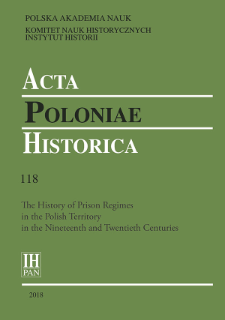
Object
Title: Double-Track System in Polish Criminal Law : Political and Criminal Assumptions, History, Contemporary References
Subtitle:
The History of Prison Regimes in the Polish Territory in the Nineteeth and Twentieth Centuries ; Acta Poloniae Historica T. 118 (2018)
Contributor:
Institute of History of the Polish Academy of Sciences ; Polish National Historical Committee ; Cieszyńska-Klimek, Magda : Trans.
Publisher:
Instytut Historii im. Tadeusza Manteuffla Polskiej Akademii Nauk
Place of publishing:
Description:
Type of object:
Abstract:
The authors of the penal code of 1932 modelled their reaction measures on the best contemporary standards. The system of criminal response was based on a double-track model, in German called zwei Spuren, in Italian – doppio binario, in which, along with penalties, there were also preventive measures. This system grew out of certain political and criminal assumptions of the sociological school, expressed most fully in the works of Franz von Liszt. Return in contemporary law, to the wide use of preventive measures, post and pre-penal, forces us to return to the sources and to critically examine the assumptions of the indicated approach, including the idea of an incorrigible criminal who should be isolated, not in relation to what he did, but because of who he is. Tracing the history of regulations, in particular their practical application should be a lesson for modern lawmakers.
References:
Batawia Stanisław, ‘Niepoprawni przestępcy w świetle 150 wyroków z art. 84 k.k.’, Archiwum Kryminologiczne, ii, 3–4 (1937).
Drenkhahn Kirstin, ‘Secure preventive detention in Germany: Incapacitation or treatment intervention’, Behavioral Sciences & the Law, xxxi (2013), 312–27.
Górny Jerzy, Elementy indywidualizacji i humanizacji karania w rozwoju penitencjarystyki (Warszawa, 1996).
Kwieciński Adam, Lecznicze środki zabezpieczające w polskim prawie karnym i praktyka ich wykonywania (Warszawa, 2009).
Pelissero Marco, The doppio binario in Italian criminal law, https://studylib.net/ doc/10742443/the-doppio-binario-in-italian-criminal-law--marco-pelissero [Accessed: 15 Jan. 2019].
Rabinowicz Leon, Podstawy nauki o więziennictwie (Warszawa, 1933).
Simple Janet, Bentham’s Prison: A Study of the Panopticon Penitentiary (Oxford, 1993).
Wąsowicz Marek, Nurt socjologiczny w polskiej myśli prawnokarnej (Warszawa, 1989).
Wetzell Richard F., Inventing the Criminal. A History of German Criminology, 1880–1945 (Chapel Hill and London, 2000).
Zalewski Wojciech, ‘Therapeutic and Legislative Approaches to Sex Offenders in Poland’, Monatsschrift für Kriminologie und Strafrechtsreform, xcvii, 1 (2014), Gunda Wößner (ed.), Developing Sexual Offender Laws and Treatment in Europe, 48–56.
Zalewski Wojciech, Przestępca ‘niepoprawny’ – jako problem polityki kryminalnej (Gdańsk, 2010).
Relation:
Volume:
Start page:
End page:
Detailed Resource Type:
Format:
Resource Identifier:
oai:rcin.org.pl:71877 ; 0001-6829 ; 2450-8462 ; 10.12775/APH.2018.118.02
Source:
IH PAN, sygn. A.295/118 Podr. ; IH PAN, sygn. A.296/118 ; click here to follow the link
Language:
Rights:
Creative Commons Attribution BY-ND 4.0 license
Terms of use:
Copyright-protected material. [CC BY-ND 4.0] May be used within the scope specified in Creative Commons Attribution BY-ND 4.0 license, full text available at: ; -
Digitizing institution:
Institute of History of the Polish Academy of Sciences
Original in:
Library of the Institute of History PAS
Projects co-financed by:
National Programme for the Development of the Humanities
Access:
Object collections:
- Digital Repository of Scientific Institutes > Partners' collections > Institute of History PAS > Serials
- Digital Repository of Scientific Institutes > Partners' collections > Institute of History PAS > Institute Publications
- Digital Repository of Scientific Institutes > Partners' collections > Institute of History PAS > Institute Publications > Journals
- Digital Repository of Scientific Institutes > Partners' collections > Institute of History PAS > Institute Publications > Journals > Acta Poloniae Historica
- Digital Repository of Scientific Institutes > Literature > Journals/Articles
Last modified:
Sep 22, 2023
In our library since:
May 30, 2019
Number of object content downloads / hits:
458
All available object's versions:
https://rcin.org.pl/publication/93535
Show description in RDF format:
Show description in RDFa format:
Show description in OAI-PMH format:
Objects Similar
Kudlak, Grzegorz Zimny, Mateusz
Sadowski, Marcin
Hass, Ludwik (1918–2008)
Tripplin, Teodor (1813–1881)
Tripplin, Teodor (1813–1881)
Neufeld, Carl (1856–1918) Verlag Wilhelm Spemann. Wydawca

 INSTYTUT ARCHEOLOGII I ETNOLOGII POLSKIEJ AKADEMII NAUK
INSTYTUT ARCHEOLOGII I ETNOLOGII POLSKIEJ AKADEMII NAUK
 INSTYTUT BADAŃ LITERACKICH POLSKIEJ AKADEMII NAUK
INSTYTUT BADAŃ LITERACKICH POLSKIEJ AKADEMII NAUK
 INSTYTUT BADAWCZY LEŚNICTWA
INSTYTUT BADAWCZY LEŚNICTWA
 INSTYTUT BIOLOGII DOŚWIADCZALNEJ IM. MARCELEGO NENCKIEGO POLSKIEJ AKADEMII NAUK
INSTYTUT BIOLOGII DOŚWIADCZALNEJ IM. MARCELEGO NENCKIEGO POLSKIEJ AKADEMII NAUK
 INSTYTUT BIOLOGII SSAKÓW POLSKIEJ AKADEMII NAUK
INSTYTUT BIOLOGII SSAKÓW POLSKIEJ AKADEMII NAUK
 INSTYTUT CHEMII FIZYCZNEJ PAN
INSTYTUT CHEMII FIZYCZNEJ PAN
 INSTYTUT CHEMII ORGANICZNEJ PAN
INSTYTUT CHEMII ORGANICZNEJ PAN
 INSTYTUT FILOZOFII I SOCJOLOGII PAN
INSTYTUT FILOZOFII I SOCJOLOGII PAN
 INSTYTUT GEOGRAFII I PRZESTRZENNEGO ZAGOSPODAROWANIA PAN
INSTYTUT GEOGRAFII I PRZESTRZENNEGO ZAGOSPODAROWANIA PAN
 INSTYTUT HISTORII im. TADEUSZA MANTEUFFLA POLSKIEJ AKADEMII NAUK
INSTYTUT HISTORII im. TADEUSZA MANTEUFFLA POLSKIEJ AKADEMII NAUK
 INSTYTUT JĘZYKA POLSKIEGO POLSKIEJ AKADEMII NAUK
INSTYTUT JĘZYKA POLSKIEGO POLSKIEJ AKADEMII NAUK
 INSTYTUT MATEMATYCZNY PAN
INSTYTUT MATEMATYCZNY PAN
 INSTYTUT MEDYCYNY DOŚWIADCZALNEJ I KLINICZNEJ IM.MIROSŁAWA MOSSAKOWSKIEGO POLSKIEJ AKADEMII NAUK
INSTYTUT MEDYCYNY DOŚWIADCZALNEJ I KLINICZNEJ IM.MIROSŁAWA MOSSAKOWSKIEGO POLSKIEJ AKADEMII NAUK
 INSTYTUT PODSTAWOWYCH PROBLEMÓW TECHNIKI PAN
INSTYTUT PODSTAWOWYCH PROBLEMÓW TECHNIKI PAN
 INSTYTUT SLAWISTYKI PAN
INSTYTUT SLAWISTYKI PAN
 SIEĆ BADAWCZA ŁUKASIEWICZ - INSTYTUT TECHNOLOGII MATERIAŁÓW ELEKTRONICZNYCH
SIEĆ BADAWCZA ŁUKASIEWICZ - INSTYTUT TECHNOLOGII MATERIAŁÓW ELEKTRONICZNYCH
 MUZEUM I INSTYTUT ZOOLOGII POLSKIEJ AKADEMII NAUK
MUZEUM I INSTYTUT ZOOLOGII POLSKIEJ AKADEMII NAUK
 INSTYTUT BADAŃ SYSTEMOWYCH PAN
INSTYTUT BADAŃ SYSTEMOWYCH PAN
 INSTYTUT BOTANIKI IM. WŁADYSŁAWA SZAFERA POLSKIEJ AKADEMII NAUK
INSTYTUT BOTANIKI IM. WŁADYSŁAWA SZAFERA POLSKIEJ AKADEMII NAUK


































